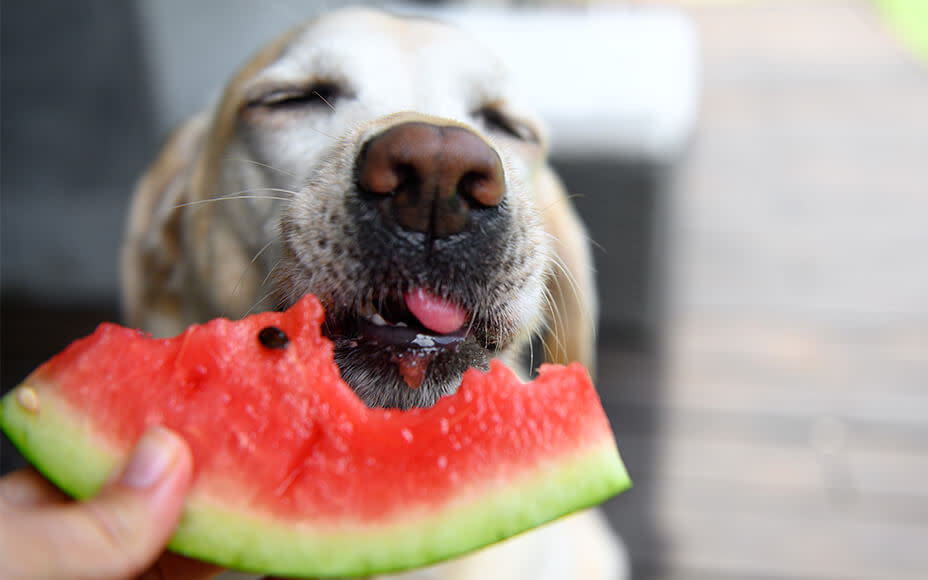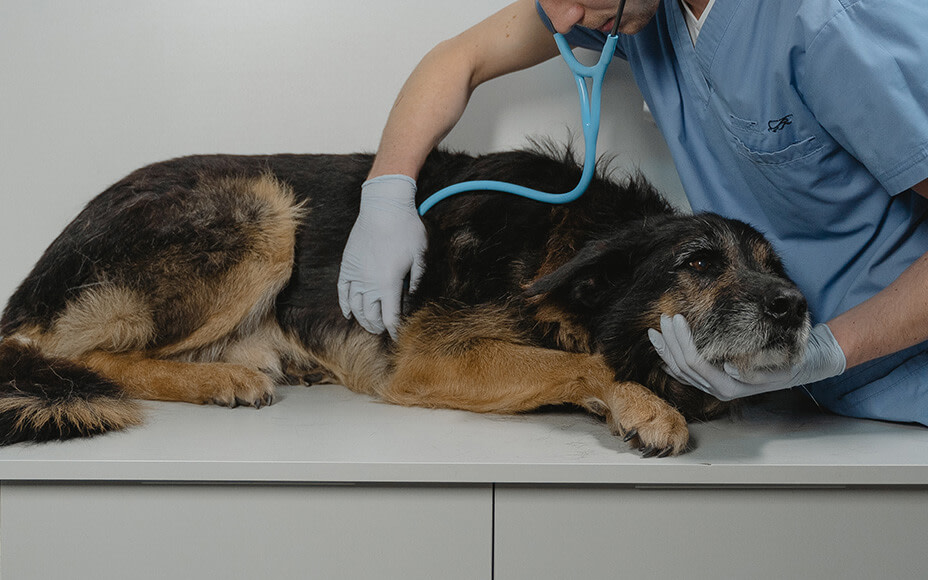Is fruit as healthy for dogs as it is for us? What types of fruits can dogs eat, and which are toxic? Learn everything about feeding fruit to your dog.
- Feeding Fruit to Dogs – Is it Species-Appropriate?
- Which Fruits Can Dogs Eat?
- Safe Fruits for Dogs
- Fruits for Dogs that Should Be Fed with Caution
- Toxic Fruits That MUST NOT Be Fed to Dogs
- Help, My Dog Ate Poisonous Fruit or Vegetables!
- Which Fruits Are Good for Dogs’ Digestion?
- How Much Fruit Can a Dog Eat?
Feeding Fruit to Dogs – Is it Species-Appropriate?
The idea that “dogs are true carnivores” still persists. So why feed them bananas, apples, and the like? After all, the dog is descended from wolves, and wolves primarily ate meat! Well, precisely because the wolf is the ancestor of our dogs, fruits are also part of a species-appropriate and balanced dog diet.
Let’s take a look at the wolf’s menu: from its prey, it doesn’t just eat the muscle meat but devours it with skin and fur or cartilage and organs, including plant residues in the stomach. Its daily menu is supplemented with fruits like berries or other vegetation, which is why dogs are classified as carnivores and omnivores (“carni-omnivor”).
Therefore, feeding fruits and vegetables to our four-legged friends is essential. Just like us humans (and wolves), they also rely on the vitamins, fiber, and trace elements contained in fruits. Thus, feeding fruit contributes to maintaining your dog’s health and can lead to deficiencies and health restrictions if not adequately supplied.
Which Fruits Can Dogs Eat?
Many fruit varieties make delicious and healthy snacks for dogs. However, it is crucial to consider which fruit can be fed and how. Seeds and peel are usually toxic. Also, avoid feeding too much fruit at once, as it can cause digestive issues like diarrhea.
Additionally, in a high-quality complete dog food, all essential nutrients, including meat, fruit, vegetables, fats, and minerals, are already present in sufficient quantities and generally do not need additional supplementation.
Our food only contains the best of the best. In addition to juicy meat, our range includes various fruits such as apples, raspberries, bananas, mangoes, pears, blackberries, and much more. Take a look and discover your dog’s new favorite food!
Safe Fruits for Dogs
These fruit varieties can be easily consumed by your dog. They are generally not bloating and, when cut small or pureed, are easily digestible. Remember to remove seeds and possibly the peel beforehand.
- Apple
- Apricots
- Bananas
- Blueberries
- Cranberries
- Dates
- Strawberries
- Pomegranate
- Raspberries
- Currants
- Nectarines (seedless)
- Papaya
- Plums
- Pomelo
- Gooseberries
If your dog is not accustomed to occasional raw fruit feeding, start with a small amount and gradually introduce it. Due to the numerous fibers and fruit acids in fruit, it can sometimes lead to stomachaches.

Fruits for Dogs that Should Be Fed with Caution
Be a bit more cautious when feeding these fruit varieties. Generally, they are not toxic, but there are a few things to consider. Also, with these fruits, remove seeds and peel if necessary!
- Pineapple (only feed overripe and not too much; it contains a lot of acid)
- Pears (feed only when overripe)
- Figs (can have a laxative effect)
- Persimmon or Sharon fruit (safe but contains a lot of sugar)
- Cherries (remove pits; can have a laxative and bloating effect)
- Kiwi (do not feed too much; it contains a lot of acid)
- Mandarins (feed only in small quantities)
- Mango (safe but contains a lot of sugar)
- Melons (feed only when overripe; do not feed the flesh near the peel)
- Oranges (feed only small amounts and when overripe)
- Lemons (do not feed too much; it contains a lot of acid)
Toxic Fruits That MUST NOT Be Fed to Dogs
Unlike vegetables, there are few fruit varieties that may not be well-tolerated or can even be toxic for your dog. To ensure nothing harmful lands in your dog’s bowl at home, take a close look at the following fruit varieties:
- Grapes (toxic!)
- The pit of cherries, nectarines, peaches. Biting into the pits can release poisonous cyanide.
Help, My Dog Ate Poisonous Fruit or Vegetables!
Your dog helped itself to grapes without permission? Depending on the size and weight of your furry friend, the first symptoms of poisoning can set in fairly quickly. Initial signs of poisoning include heavy panting, restlessness, and trembling.
But don’t panic; now a clear head and prompt action are crucial! In a veterinary clinic, your dog will be induced to vomit with an injection, allowing the poisonous fruit or vegetable to be expelled as quickly as possible. It’s important not to take matters into your own hands – never try to induce vomiting in your dog yourself. Also, avoid using remedies from the household pharmacy, as they can be toxic to dogs and are therefore off-limits.

Which Fruits Are Good for Dogs’ Digestion?
If your canine companion has a sensitive stomach and occasionally experiences rumbling in the belly, you can feed a bit of grated apple or some mashed banana. However, you should avoid fruits with high acidity, such as pineapple, mango, kiwi, or berries.
SOS! Your dog has acute diarrhea or vomiting? Cooked carrots, rice, and chicken in a pot make a soothing bland diet that you can feed your dog for 3-5 days if they are struggling. If you need a quick solution and don’t have time to cook, just open a can of our special wet food “Vet” Stomach & Intestine Fit with chicken, cottage cheese, and rice.
How Much Fruit Can a Dog Eat?
Even though fruit is healthy and full of vitamins, you shouldn’t give your dog too much of it. Many fruits contain a lot of fruit acid and fruit sugar, both of which can impact a dog’s digestion. Therefore, start by feeding your dog a small amount of fruit and observe how well they tolerate it. The amount fed depends on your dog’s size and weight.
If you want to regularly feed your dog fruit, adjust the quantity to your dog’s daily nutritional needs. If you feed your dog dry or wet food, all individual nutrients, including proteins, vitamins, carbohydrates, minerals, fats, fibers, and trace elements, are already present in sufficient quantities. That means everything you feed your dog in terms of fruit should be in addition to its regular food and ideally deducted from its daily intake. This is not as straightforward with a complete ready-made pet food, so it’s best to stick to a small handful of blueberries or a piece of apple occasionally.
If you want to feed fruits and vegetables regularly and in larger quantities, the BARFing concept might be for you. Here, you prepare your dog’s food fresh, assembling the meal with its individual components like meat, fruit, vegetables, and carbohydrates. The respective amounts must, of course, be tailored to your dog’s needs.
Find this too complicated? Supporters of BARFing wouldn’t want to miss this feeding method once they’ve gotten the hang of it, but we can understand if it seems too involved for you. That’s why we’ve developed “BARF Complete,” allowing you to feed your dog easily and simultaneously with tasty, fresh ingredients. The menu already contains everything your four-legged friend needs daily: fresh meat, fruit, and vegetables, as well as minerals and oils. All measured and pre-portioned, super fresh and delicious!


